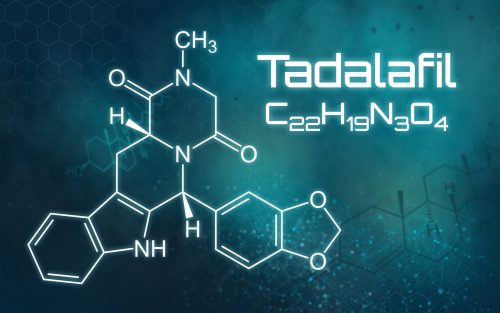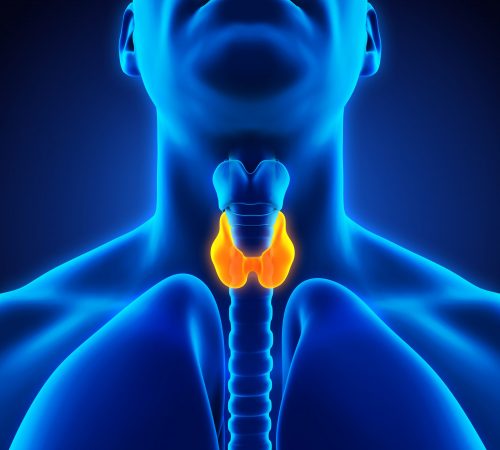TRT & Tadalafil – It’s Not Just About Erections!

Tadalafil is a drug commonly discussed in the world of Testosterone Replacement Therapy (TRT). It is a medication that’s primary use is within the realms of erectile dysfunction, which you’ve probably have heard of before by it’s more commonly known brand name ‘Cialis’. In the context of TRT however, our primary use of this drug is not really for erectile dysfunction, but that is not to say that this is not a positive benefit that is observed when using it. Let’s take a deeper look at Tadalafil and its role in TRT.
What Exactly is Tadalafil?
Tadalafil is a medication which comes under the class of selective PDE 5 inhibitors. It is in the same class of drug as a much more commonly known drug used for erectile dysfunction named ‘Sildenafil’, more commonly known as ‘Viagra’, which most people have heard of.
How Does it Work?
To understand that we need to dig into biochemistry to understand the physiology.
PDE 5 stands for Phosphodiesterase 5. What is PDE5? PDE5 is an enzyme that is found within the walls of blood vessels and its role is to affect blood flow and cell signalling. It inhibits Cyclic Guanosine Monophosphate or cGMP. cGMP is a very common cell signalling substance that regulates ion channel conductance [1]. This inhibition causes a relaxation of blood vessels which increases blood flow, we call that in medical terms vasodilation.
Now whilst we are on the subject of the pharmacology of tadalafil we need to talk about its safe use. Tadalafil is a prescription only medication that should only ever be taken when provided by a qualified prescribing clinician. One of the main reasons for this is that nearly all medications are subjected to metabolism via what is known as the P450 Cytochrome system. This is a group of enzymes that play a role on the breakdown of medications through the liver [2]. Tadalafil specifically interacts with CYP3A4 a specific enzyme within the P450 cytochrome. Now this system can be inhibited and induced by certain medications. So Tadalafil must be prescribed with caution alongside any other medication that may cause inhibition or inducement of the P450 cytochrome. For example, Tadalafil should be administered with caution alongside Nitrate medications, however these are not as commonly used nowadays outside of specialist cardiac care. Its concurrent administration with more common medications such as the antibiotics erythromycin and clarithromycin which are both CYP3A4 inhibitors as are grapefruit juice and Naringenin supplements and these will increase the plasma concentration levels of tadalafil up to 2-4 fold.
Equally, certain epilepsy medications such as phenytoin, phenobarbital and carbamazepine should be avoided as these are CYP3A4 inducers and may reduce plasma concentration levels of tadalafil by up to 88% and therefore reduce the efficacy [3].
What Are the Benefits of Using Tadalafil as Part of Your TRT Protocol?
The first and most obvious benefit would be the alleviation of erectile dysfunction which is commonly seen in those with testosterone deficiency. However, if we think back to the mechanism of action, the vasodilation is not restricted to the corpus cavernosum, which is the erectile tissue found within the penis. The vasodilatory effect can be found in other tissues such as the smooth muscle of the prostate and bladder which is beneficial to those suffering with benign prostatic hyperplasia or more simply an enlarged prostate not secondary to a sinister pathology [4]. This vasodilatory effect also effects skeletal muscle, visceral smooth muscle and also to a lesser degree cardiac muscle, kidneys and the liver. Although, these aforementioned organs primarily utilise PDE1, 2 and 4 for their particular cell signalling purposes [5].
Another benefit of its use is reduction in blood pressure. This is interesting as the studies that have been conducted in a controlled environment do not seem to replicate this effect [6]. However, it is something that a lot of our patients have reported and commensurately has been observed in the clinic’s patients.
Interestingly there is evidence in the literature that supports one of the main benefits that we here at TMHC utilise this medication for, and that is a reduction of serum oestradiol levels [7]. Again, this is something THMC have observed in clinical practice and the limited studies around this topic do demonstrate this effect. The caveat from the evidence base around this particular effect is that in one 2016 study by Aversa et al [8] the reduction in oestradiol levels was primarily observed in those without excess central adiposity, i.e.. men with a healthy lean muscle mass. This particular application of Tadalafil can sometimes mean the difference between requirement for aromatase inhibitor medication and not. So, that’s further motivation to moderate your diet and exercise.
On the subject of weight management, those patients on TRT who do regular resistance training may also see an additional benefit in reduced muscle soreness and reduced recovery time due to the increased blood flow to the muscle groups being stressed during training [9].
Finally, another useful benefit that Tadalafil confers is demonstrated in a 2010 study by Foresta et al [10] that showed that Tadalafil has a positive effect on vascular endothelial cell regeneration by increasing the amount of endothelial progenitor cells and CXCR4 expression which is linked to the cGMP cellular messenger system resulting in improved repair of vascular damage. Put more simply it helps to improve the repair and recovery of the lining of blood vessel walls thus improving cardiovascular health and longevity.
Dosing?
Tadalafil has a half-life of between 17-21 hours and a peak plasma concentration time or cMax of approximately 2 hours. So stable serum concentration levels can be achieved quite quickly on a daily dosing regimen. Now, if we were to use Tadalafil for its primary clinical indication of erectile dysfunction you would look to utilise a dose of 10 to 20mg. As many will know, at the men’s health clinic we focus on balance and stability, so we are advocates of microdosing to give stable serum concentration levels. As has been mentioned before we subscribe to daily microdosing of testosterone cypionate and HCG and when it comes to Tadalafil we are no different. We use a dose of between 2.5 to 5mg daily via oral administration and will titrate that dose to the desired effect.
Are There Any Side Effects?
As with all medications there will always be a list of side effects. The most common reported side effects when using Tadalafil are:
- Headache
- Back pain
- Dyspepsia (so acid reflux/indigestion)
- Facial flushing
- Nasal congestion
Anecdotally in our clinical experience, these side effects tend to settle between weeks 2-6 on a daily microdosing regimen. If the dyspepsia or acid reflux does not settle, you can first look to moderate your diet and if there is still no relief, you can approach your GP about medications that can help with this.
Summary
To summarise, the benefits of using tadalafil in a microdosing manner alongside TRT are:
- Relief of erectile dysfunction symptoms
- Relief of symptoms associated with benign prostatic hyperplasia
- Blood pressure modulation
- Oestradiol modulation
- Increased cardiovascular health through endothelial cell regeneration
- The potential for reduced muscle soreness and reduced recovery time post resistance training.
In conclusion, Tadalafil is not all about erections. It has many other befits alongside a well-balanced TRT protocol.
References
[1] Lue, T., 2000. Erectile Dysfunction. New England Journal of Medicine, 342(24), pp.1802-1813.
[2] Bernhardt, R., 2006. Cytochromes P450 as versatile biocatalysts. Journal of Biotechnology, 124(1), pp.128-145.
[3] Medicines.org.uk. 2022. Tadalafil 10 mg film-coated tablets – Summary of Product Characteristics (SmPC) – (emc). [online] Available at: <https://www.medicines.org.uk/emc/product/8636> [Accessed 23 March 2022].
[4] Mónica, F. and De Nucci, G., 2019. Tadalafil for the treatment of benign prostatic hyperplasia. Expert Opinion on Pharmacotherapy, 20(8), pp.929-937.
[5] Coward, R. and Carson, C., 2008. Tadalafil in the treatment of erectile dysfunction. Therapeutics and Clinical Risk Management, Volume 4, pp.1315-1329.
[6] Kloner, R., Mitchell, M. and Emmick, J., 2003. Cardiovascular effects of tadalafil. The American Journal of Cardiology, 92(9), pp.37-46.
[7] Greco, E., Pili, M., Bruzziches, R., Corona, G., Spera, G. and Aversa, A., 2006. Testosterone:Estradiol Ratio Changes Associated with Long‐Term Tadalafil Administration: A Pilot Study. The Journal of Sexual Medicine, 3(4), pp.716-722.
[8] Aversa, A., Fittipaldi, S., Bimonte, V., Wannenes, F., Papa, V., Francomano, D., Greco, E., Lenzi, A. and Migliaccio, S., 2015. Tadalafil modulates aromatase activity and androgen receptor expression in a human osteoblastic cell in vitro model. Journal of Endocrinological Investigation, 39(2), pp.199-205.
[9] Sheffield-Moore, M., Wiktorowicz, J., Soman, K., Danesi, C., Kinsky, M., Dillon, E., Randolph, K., Casperson, S., Gore, D., Horstman, A., Lynch, J., Doucet, B., Mettler, J., Ryder, J., Ploutz-Snyder, L., Hsu, J., Jahoor, F., Jennings, K., White, G., McCammon, S. and Durham, W., 2013. Sildenafil Increases Muscle Protein Synthesis and Reduces Muscle Fatigue. Clinical and Translational Science, 6(6), pp.463-468.
[10] Foresta, C., De Toni, L., Magagna, S., Galan, A. and Garolla, A., 2010. Phosphodiesterase-5 Inhibitor Tadalafil Acts on Endothelial Progenitor Cells by CXCR4 Signalling. Current Drug Delivery, 7(4), pp.274-282.


